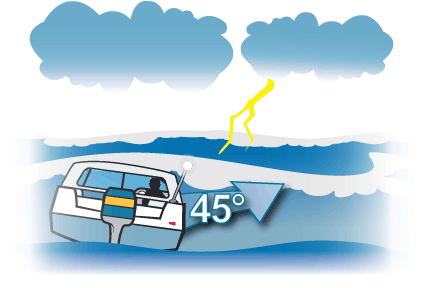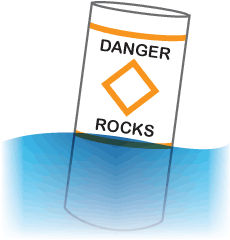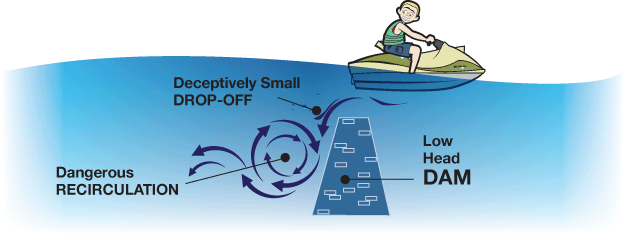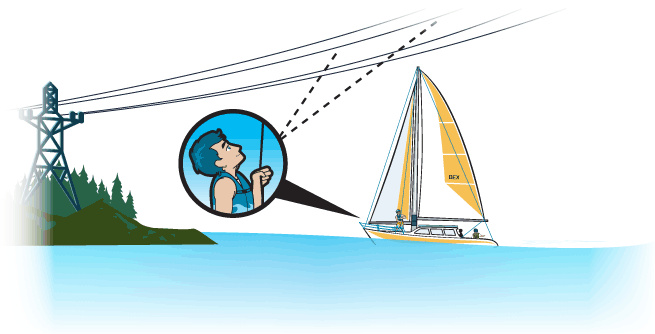Which Of The Following Is A Sign That The Weather May Change For The Worse?
Checking Local Weather and H2o Conditions
Earlier any boating trip, you should check the short-term and long-term local atmospheric condition forecast as reported on the radio, TV or Cyberspace. Y'all should always factor these weather forecasts into your preparations every bit you make your trip program. For example, you'll want to avert sure types of weather whenever possible, such as heavy fog or strong winds. Yous'll as well desire to pay particular attention to hurricane warnings; you should never go boating if there is a hurricane warning in effect.
Once on the water, melody a portable radio to a VHF-FM conditions station that broadcasts the National Oceanic and Atmospheric Assistants (NOAA) to get authentic, detailed and up-to-engagement atmospheric condition information. Due north-O-A-A Weather Radio is oft updated and covers the coastal areas of continental United States, Alaska, Hawaii, and the Mariana Islands with continuous weather broadcasts. It's your best resource for weather information while on the water. You'll observe the NOAA broadcasts on the following frequencies:
| WX1 | WX2 | WX3 |
|---|---|---|
| 162.550 MHz | 162.400 MHz | 162.475 MHz |
These broadcasts include conditions information like temperature, humidity, moving ridge atmospheric condition, barometric force per unit area, too every bit air current speed and direction---all important factors for determining when and where to gunkhole, and when to head for shore.
Monitor Conditions While on the H2o
Since the conditions can modify very quickly, particularly when you lot're out on the water, it is vital that you pay close attention to weather forecasts and anticipate atmospheric condition changes whenever possible.
Here are some tips for keeping on summit of weather condition changes while out on the water:
- Always keep an heart to the sky. Fog, night clouds and lightning are clear signs that bad atmospheric condition is approaching.
- Monitor barometric readings. A rising barometer is a sign that adept conditions is coming while a falling barometer indicates that foul weather is likely.
- Pay close attention to shifts in the wind direction and temperature; these are signs that the weather is changing.
- Be mindful of the Due west as bad weather usually approaches from this direction. Storms from the East often pack quite a wallop.
- Continually monitor your radio and atmospheric condition channels and inquire for information virtually local weather patterns past radio, especially if you're in unfamiliar waters.
Finally, accept note of what other boaters are doing. If they're heading for shore, it tin give you a heads up most coming weather changes.
Boating in Crude Water
If you lot're out on the h2o and a storm is heading your way, you should prepare yourself, your passengers and your boat past taking the following steps:
- Brand certain that everyone on board is wearing a lifejacket and that it is secured properly.
- Reduce your speed and go on with circumspection, keeping an heart out for other boats and floating debris.
- Close all hatches and ports to avert swamping.
- For stability and safety, get your passengers to stay low in the gunkhole near the centerline.
- Secure any loose items to avoid losing them overboard.
- Pump out the bilges then that your boat sits higher in the h2o.
- Check marine charts to find the nearest shelter, noting whatsoever hazards in the expanse;
- And go on charily to the nearest safe shoreline.
If a storm has already hit, hither are some additional tips to ensure the safety of everyone on board:
- If at that place is lightning, unplug all electric equipment. Stay low in the boat and abroad from metal objects.
- Head the bow of the boat into waves at a 45-degree angle. This will go on the boat in the most stable position.
- If your engine stops, drib an anchor from the bow to combat drifting and swamping. Never drop anchor from the stern.

Remember, whenever you are boating in stormy weather, your starting time pace is to make sure that all persons on lath are wearing United States Coast Guard-approved personal flotation devices.
Checking Local Hazards: Obtain Atmospheric condition Forecast Information

It'south important to larn near local hazards before going canoeing in whatsoever new or unfamiliar waters. You lot can do this by obtaining local marine charts and/or checking with local boaters and marinas.
Local boaters and marinas typically have a wealth of knowledge about canoeing in their area and are usually more than happy to share it.
You should as well notice out if there are local rules such as horsepower restrictions, hours of operation, or admission to locking operations that could bear on your trip.
Now let'south review some of the hazards that you'll desire to be enlightened of when boating.
Local Hazards to be Wary of:
Whitewater Areas
Whitewater areas can very easily drag a boat or person downstream. Rocks, debris, too equally a strong, rushing electric current, are some of the dangers of whitewater.
Shoaling Areas
Shoaling areas (marked and unmarked) become shallow gradually and are often difficult to spot without local charts.
Chancy Inlets
Hazardous inlets can produce abnormal currents or changes in water levels.
Abnormal Tides or Currents
Abnormal tides or currents can impact your ability to properly navigate or steer your vessel.
Depression-Head Dams
Depression-head dams pose a risk both below and in a higher place the dam. Minor vessels, objects and people tin can get trapped in the hydraulic 'pigsty' at the base of these dams, creating a dangerous situation. Ever be on the scout for warning signs or buoys indicating low-head dams.
Annotation: Low-head dams are especially chancy to paddle arts and crafts. If you are paddling near a depression-head dam, always endeavour to avoid it, or portage your gunkhole and its cargo overland around the dam. Getting trapped in a depression-head dam can be fatal. Keep a sharp lookout and avoid them!

Powerlines
Powerlines pose a item hazard for sailing vessels, or whatever vessel with a mast. Brand sure that your vessel has enough clearance to safely laissez passer beneath any powerlines, and if you are unsure, don't take the hazard.

Low Seasonal Waters
Low seasonal waters practise not appear on local charts, which evidence only the average water level. Y'all'll desire to proceed in mind that waters are by and large college in the leap and lower in the summer. Brand adjustments for depression seasonal waters, every bit they make it more than likely for your boat to run aground.
Obstructions
Pay extra attending to obstructions such as bridges, channel openings and commercial angling nets. When y'all are close to these types of obstructions, proceed with caution.
Low-caput dams are hard to detect downstream.
Source: https://www.boaterexam.com/boating-resources/boating-weather-rough-water.aspx#:~:text=Fog%2C%20dark%20clouds%20and%20lightning,that%20bad%20weather%20is%20approaching.&text=Pay%20close%20attention%20to%20shifts,that%20the%20weather%20is%20changing.
Posted by: brownarand1988.blogspot.com


0 Response to "Which Of The Following Is A Sign That The Weather May Change For The Worse?"
Post a Comment